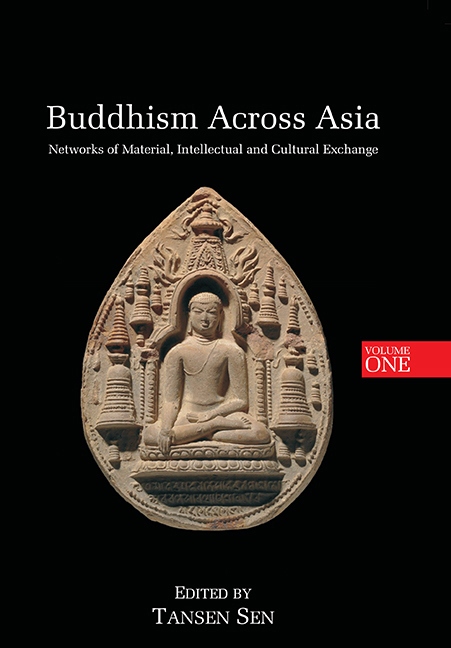Book contents
- Frontmatter
- Dedication
- Contents
- Introduction: Buddhism in Asian History
- Part I Tran smissions of Buddhism Before the Seventh Century
- 1 Networks for Long-distance Transmission of Buddhism in South Asian Transit Zones
- 2 Truth and Scripture in Early Buddhism: Categorial Reduction as Exegetical Method in Ancient Gandhāra and Beyond
- 3 Now You Hear it, Now You Don't: The Phrase “Thus Have I Heard” in Early Chinese Buddhist Translations
- 4 The First Āgama Transmission to China
- 5 What is a “Hīnayāna Zealot” Doing in Fifth-Century China?
- 6 Meditation Traditions in Fifth-Century Northern China: With a Special Note on a Forgotten “Kaśmīri” Meditation Tradition Brought to China by Buddhabhadra (359-429)
- 7 Transmission of the Dharma and Reception of the Text: Oral and Aural Features in the Fifth Chapter of the Book of Zambasta
- Part II Buddhism Across Asia between the Seventh and Fifteenth Centuries
- Part III Buddhist Connections after the Fifteenth Century
- List of Contributors
- Index
- Miscellaneous Endmatter
1 - Networks for Long-distance Transmission of Buddhism in South Asian Transit Zones
from Part I - Tran smissions of Buddhism Before the Seventh Century
Published online by Cambridge University Press: 21 October 2015
- Frontmatter
- Dedication
- Contents
- Introduction: Buddhism in Asian History
- Part I Tran smissions of Buddhism Before the Seventh Century
- 1 Networks for Long-distance Transmission of Buddhism in South Asian Transit Zones
- 2 Truth and Scripture in Early Buddhism: Categorial Reduction as Exegetical Method in Ancient Gandhāra and Beyond
- 3 Now You Hear it, Now You Don't: The Phrase “Thus Have I Heard” in Early Chinese Buddhist Translations
- 4 The First Āgama Transmission to China
- 5 What is a “Hīnayāna Zealot” Doing in Fifth-Century China?
- 6 Meditation Traditions in Fifth-Century Northern China: With a Special Note on a Forgotten “Kaśmīri” Meditation Tradition Brought to China by Buddhabhadra (359-429)
- 7 Transmission of the Dharma and Reception of the Text: Oral and Aural Features in the Fifth Chapter of the Book of Zambasta
- Part II Buddhism Across Asia between the Seventh and Fifteenth Centuries
- Part III Buddhist Connections after the Fifteenth Century
- List of Contributors
- Index
- Miscellaneous Endmatter
Summary
Introduction
Networks of cross-cultural exchange served as channels for the movement of Buddhism across Asia. Just as trade networks facilitate long-distance economic transactions, religious networks contribute to the mobility of beliefs and practices, as well as dynamic processes of migration, conversion, pilgrimage, and monastic expansion. Network analysis has been applied more extensively to the natural and social sciences, particularly economics, but scholars in the humanities, in general, and religious studies, in particular, tend to suspect that network models are overly functional, reductionist, and deterministic. Critics of network analysis observe that extreme applications severely limit the role of intention and agency since models aim to show how actors are governed by systematic patterns in a structured system. However, Buddhist monks, missionaries, pilgrims, and other religious agents are not merely acted upon by static structures but create their own networks of religious mobility. Thus, parallel networks of religious exchange and transmission overlap with but are not necessarily embedded within exogenous economic, political and social networks. Religious and economic networks often share routes and hubs since centres of power and wealth have multiple functions as places of veneration and cultural production. By linking monastic communities with sources of economic and social support, Buddhist networks act as catalysts for expansion and long-distance transmission.
Buddhist archaeological, epigraphic and literary evidence demonstrates links between regional networks of shrines and monasteries that facilitated religious transmission and long-distance trade networks. From the earliest periods, wealthy and powerful donors funded stūpas and monasteries in locations near cities and in prosperous rural areas with surplus resources to support monastic communities. Patterns in the distribution of Buddhist material remains reflect symbiotic relationships between the growth of trade networks, the support of rulers, and the expansion of Buddhism across geographical and cultural boundaries. As the establishment and survival of residential Buddhist monasteries depended on basic material conditions, the growth of the samgha was directly tied to the generosity of wealthy donors, including merchants involved in commercial exchanges. While Buddhist institutional expansion is not fully determined by economics alone (since other social and cultural factors are also necessary to stimulate donations in exchange for religious merit), religious and economic spheres are mutually imbricated.
- Type
- Chapter
- Information
- Buddhism Across AsiaNetworks of Material, Intellectual and Cultural Exchange, volume 1, pp. 3 - 18Publisher: ISEAS–Yusof Ishak InstitutePrint publication year: 2014



